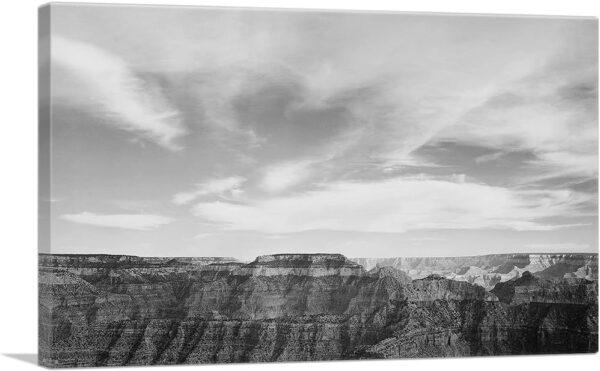Ansel Adams, a celebrated American photographer, left an indelible mark on the world of photography with his iconic black and white photograph titled “View of the Grand Canyon, Hopi Point.” Captured in 1942, this masterpiece is not only a visual delight but also a historical testament to the beauty of the American national parks. In this blog article, we delve into the details of Adams’ remarkable photograph, exploring its significance, composition, and enduring legacy.
Historical Context:
Ansel Adams’ photograph of the Grand Canyon is part of a collection commissioned by the National Park Service in 1941. During this time, the United States was immersed in World War II, and the government sought to boost morale and promote the nation’s natural treasures through these breathtaking images. Adams, known for his expertise in landscape photography, was a natural choice for this important project.
The Composition:
The photograph captures a mesmerizing view of the Grand Canyon from Hopi Point, showcasing the canyon’s majestic walls towering over the viewer. The choice of black and white adds a timeless quality to the image, allowing the natural contours and textures of the canyon to shine. The clouds in the sky add a dynamic element, creating depth and contrast that enhances the overall impact of the photograph.
A Masterpiece of Landscape Photography:
Adams’ photograph of the Grand Canyon is hailed as a masterpiece of landscape photography. Through his lens, he skillfully conveys the grandeur and beauty of the natural world. The play of light and shadow, the intricacies of the canyon’s formations, and the vastness of the landscape all come together to create an awe-inspiring image that transcends time.
Enduring Symbol of the American West:
This photograph has become an enduring symbol of the American West. Its portrayal of the vast and untamed wilderness speaks to the nation’s frontier spirit and the intrinsic connection between the people and the land. The Grand Canyon, through Adams’ lens, becomes a representation of the raw and untouched beauty that defines America’s national parks.
Timeless Quality and Cultural Impact:
The photograph’s timeless quality has ensured its lasting impact on American culture. It continues to inspire photographers and nature enthusiasts, serving as a benchmark for capturing the essence of the natural world. The image has been reproduced, displayed, and celebrated, cementing its place as an iconic piece of American art.
Conclusion:
In conclusion, Ansel Adams’ photograph of the Grand Canyon stands as a testament to the unparalleled beauty of the natural world. Its composition, striking imagery, and historical significance make it a timeless masterpiece that resonates with audiences across generations. As we continue to marvel at the grandeur captured in this iconic photograph, it remains a beloved piece of American culture, inspiring awe and appreciation for the splendor of our national parks.

